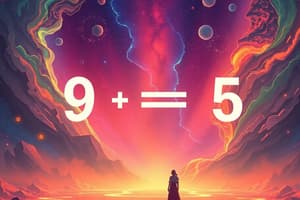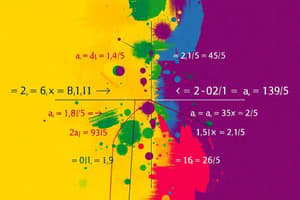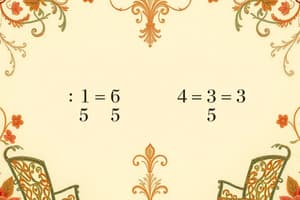Podcast
Questions and Answers
What is the formula for the probability of an event and its complement?
What is the formula for the probability of an event and its complement?
- $P(A) + P(A') = 1$ (correct)
- $P(A) imes P(A') = 1$
- $P(A) - P(A') = 1$
- $P(A) + P(A') = 0$
What is the condition for two events to be mutually exclusive?
What is the condition for two events to be mutually exclusive?
- $P(A \cap B) = 1$
- $P(A \cap B) = 0$ (correct)
- $P(A \cup B) = 1$
- $P(A \cup B) = 0$
What is the formula for the probability of the union of two mutually exclusive events?
What is the formula for the probability of the union of two mutually exclusive events?
- $P(A \cup B) = P(A) / P(B)$
- $P(A \cup B) = P(A) + P(B)$ (correct)
- $P(A \cup B) = P(A) - P(B)$
- $P(A \cup B) = P(A) imes P(B)$
What is the formula for the addition rule for any two events A and B?
What is the formula for the addition rule for any two events A and B?
What does the symbol $A'$ represent in probability?
What does the symbol $A'$ represent in probability?
What is the formula for the probability of two independent events?
What is the formula for the probability of two independent events?
What is the condition for the addition rule to simplify to $P(A ext{ or } B) = P(A) + P(B)$?
What is the condition for the addition rule to simplify to $P(A ext{ or } B) = P(A) + P(B)$?
What is the sample space represented by in probability?
What is the sample space represented by in probability?
What is the formula for the complementary rule?
What is the formula for the complementary rule?
What is the condition for two events to be dependent?
What is the condition for two events to be dependent?
What is the condition for two events A and B to be independent?
What is the condition for two events A and B to be independent?
What is the relationship between mutual exclusivity and independence?
What is the relationship between mutual exclusivity and independence?
What is the term for events that are mutually exclusive and make up the whole sample space?
What is the term for events that are mutually exclusive and make up the whole sample space?
What is the purpose of the product rule?
What is the purpose of the product rule?
What is the difference between the addition rule and the product rule?
What is the difference between the addition rule and the product rule?
Why is it important to verify if $P(A ext{ and } B) = P(A) imes P(B)$ when testing for independence?
Why is it important to verify if $P(A ext{ and } B) = P(A) imes P(B)$ when testing for independence?
What is the relationship between the probabilities of two events and their union and intersection as expressed by the addition rule?
What is the relationship between the probabilities of two events and their union and intersection as expressed by the addition rule?
What is the condition for the addition rule to simplify to P(A or B) = P(A) + P(B)?
What is the condition for the addition rule to simplify to P(A or B) = P(A) + P(B)?
What is represented by P(not A)?
What is represented by P(not A)?
When are two events A and B independent?
When are two events A and B independent?
What can be concluded about two events A and B if P(A and B) = 0?
What can be concluded about two events A and B if P(A and B) = 0?
What is necessary to verify when testing whether two events are independent?
What is necessary to verify when testing whether two events are independent?
What can be said about the relationship between the probabilities of two mutually exclusive events?
What can be said about the relationship between the probabilities of two mutually exclusive events?
What is the purpose of the complementary rule?
What is the purpose of the complementary rule?
What is the probability of the union of two mutually exclusive events A and B?
What is the probability of the union of two mutually exclusive events A and B?
If two events A and B are independent, what is the probability of A and B not occurring?
If two events A and B are independent, what is the probability of A and B not occurring?
What is the formula for the probability of an event A not occurring?
What is the formula for the probability of an event A not occurring?
What is the term for the set of all possible outcomes in a probability experiment?
What is the term for the set of all possible outcomes in a probability experiment?
If A is an event, what is the notation for the number of elements in set A?
If A is an event, what is the notation for the number of elements in set A?
What is the formula for the probability of two independent events A and B occurring?
What is the formula for the probability of two independent events A and B occurring?
What is the relationship between the probability of an event A and its complement A'?
What is the relationship between the probability of an event A and its complement A'?
If two events A and B are mutually exclusive, what is the probability of their intersection?
If two events A and B are mutually exclusive, what is the probability of their intersection?
If events A and B are mutually exclusive, what is the value of P(A or B) in terms of P(A) and P(B)?
If events A and B are mutually exclusive, what is the value of P(A or B) in terms of P(A) and P(B)?
What is the condition for the addition rule to hold for any two events A and B?
What is the condition for the addition rule to hold for any two events A and B?
If P(A) = 0.3 and P(B) = 0.5, and A and B are independent, what is P(A and B)?
If P(A) = 0.3 and P(B) = 0.5, and A and B are independent, what is P(A and B)?
If A and B are dependent, what can be said about P(A and B)?
If A and B are dependent, what can be said about P(A and B)?
What is P(not A) in terms of P(A)?
What is P(not A) in terms of P(A)?
If P(A or B) = 0.7 and P(A) = 0.4, what is P(B) if A and B are mutually exclusive?
If P(A or B) = 0.7 and P(A) = 0.4, what is P(B) if A and B are mutually exclusive?
What is the relationship between P(A) and P(not A)?
What is the relationship between P(A) and P(not A)?
If A and B are independent, what is P(A and not B) in terms of P(A) and P(B)?
If A and B are independent, what is P(A and not B) in terms of P(A) and P(B)?
If two events A and B are independent, which of the following is true?
If two events A and B are independent, which of the following is true?
What is the probability of the union of two events A and B, if they are mutually exclusive?
What is the probability of the union of two events A and B, if they are mutually exclusive?
What is the relationship between the probability of an event A and its complement A'?
What is the relationship between the probability of an event A and its complement A'?
If P(A) = 0.4 and P(B) = 0.3, what is the probability of A and B not occurring, if they are independent?
If P(A) = 0.4 and P(B) = 0.3, what is the probability of A and B not occurring, if they are independent?
What is the term for events that are mutually exclusive and make up the whole sample space?
What is the term for events that are mutually exclusive and make up the whole sample space?
If A and B are mutually exclusive, what is the value of P(A and B)?
If A and B are mutually exclusive, what is the value of P(A and B)?
What is the purpose of the product rule?
What is the purpose of the product rule?
What is the symbol for the number of elements in set A?
What is the symbol for the number of elements in set A?




